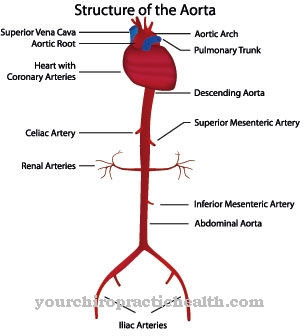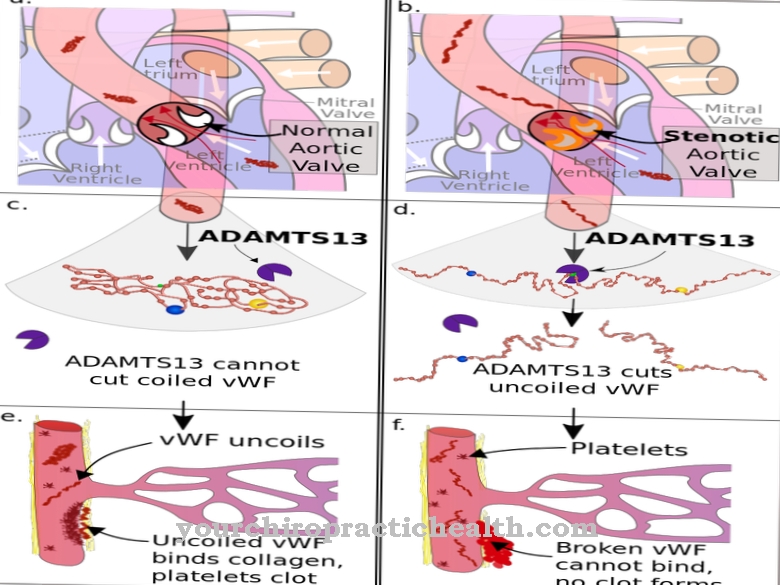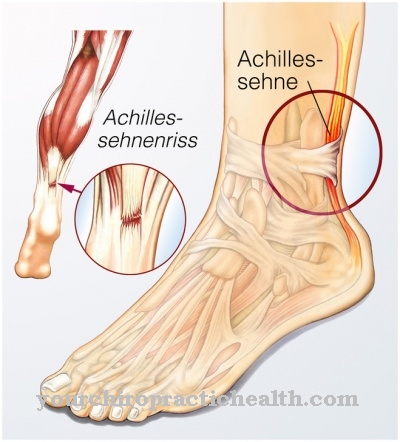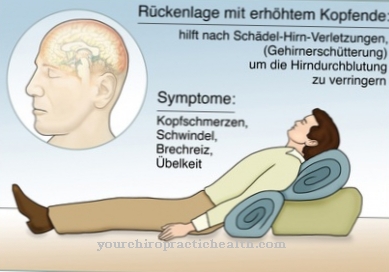A Rhinosinusitis or Inflammation of the nasal mucous membrane is a common inflammatory change of the nasal mucosa with simultaneous inflammation of the sinus mucosa. In most cases, rhinosinusitis can be traced back to a viral infection.
What is rhinosinusitis?

© Henrie - stock.adobe.com
As Rhinosinusitis is an inflammation of the nasal mucous membrane (rhinitis) in combination with an inflammatory change in the mucosa (mucous membrane) of the paranasal sinuses (sinusitis).
Depending on the course of time, a general distinction is made between an acute and a chronic variant, with chronic rhinosinusitis being used if the complaint lasts more than 12 months. In addition, in chronic rhinosinusitis, a distinction is made between the polyp-forming form and rhinosinusitis without manifestation of polyps.
Acute rhinosinusitis manifests itself in the form of a purulent (purulent) nasal discharge, a nasal obstruction and a feeling of pain and pressure in the face. In contrast, the chronic form of rhinosinusitis is less pronounced in many cases and, in addition to the more discreet acute symptoms, manifests itself through an increased susceptibility to infection, a general state of exhaustion and reduced resilience.
causes
An acute one Rhinosinusitis is an inflammatory change after a nasal infection, which leads to impaired drainage and impaired ventilation in the paranasal sinuses.
The increasing obstruction and tissue formation leads to impaired ventilation and drainage as well as the development of the chronic form. In most cases, the infection is triggered virally by influenza, parainfluenza or rhino-influenza viruses and bacterially by mycoplasmas and Chlamydia pneumoniae.
In addition, the bacterial pathogens Haemophilus influenzae and Streptococcus pneumoniae can lead to a superinfection following a viral infection. Chronic rhinosinusitis is associated with Staphylococcus aureus, Staphylococcus epidermidis, Moraxella catarrhalis and enterobacteria, among others.
The polyp-forming form of chronic rhinosinusitis is also associated with intolerance to acetylsalicylic acid, bronchial asthma and non-invasive fungal infections. Anatomically related changes in the lateral nasal wall and allergic rhinitis are considered to be favorable factors, especially for recurrent rhinosinusitis.
Symptoms, ailments & signs
Rhino-sinusitis is also known as sinusitis. It shows up as a mixture of a runny nose and blocked tubes. Doctors speak of nasal obstruction and rhinorrhea. Rhino-sinusitis can develop in various degrees of severity. These can be read off from the symptoms. A chronification of the rhino-sinusitis is possible.
The blocked nose can impair the perception of smell. The pressure in the tubes can be increased. This leads to symptoms such as headaches, feelings of pressure in the jaw and forehead area and on both sides of the bridge of the nose. At the same time, the nose is constantly running. The duration of acute rhinosinusitis is set at around 14 to 18 days.
Frequent urge to sneeze can accompany these symptoms. Nocturnal coughing is caused by the postnasal secretion. Often the nose is dense on one side at night. That makes breathing difficult. The nasal congestion, the pressure on the tubes and the nocturnal coughing irritation disrupt healthy sleep. The sleeper breathes through the mouth or snores. Both can dry out or cool the airways.
As rhino sinusitis progresses, symptoms may worsen and lead to a fever. Rhino-pharyngitis with severe hoarseness and voice problems may develop. Since there can be so many symptoms, the most distressing symptom is critical to treatment.
Diagnosis & course
A Rhinosinusitis is diagnosed on the basis of the characteristic clinical symptoms (including inflammatory changes in the nasal mucosa, nosebleeds, pronounced pain, swelling, visual impairments, sensory disorders in the trigeminal region).
In addition, in many cases of rhinosinusitis, pus (pus) can be detected rhinoscopically or by computer tomography. A nasal endoscopy enables a differentiated assessment of the nasal and paranasal mucosal structure.
In the differential diagnosis, a distinction should also be made between bacterial and viral rhinosinusitis with regard to the therapeutic measures to be selected, whereby the duration of the disease and its severity allow initial conclusions. If rhinosinusitis is diagnosed at an early stage and treated consistently, the disease will develop without complications.
If left untreated, pronounced rhinosinusitis can affect adjacent structures such as eyes, meninges or brain and, in extreme cases, lead to life-threatening meningitis or encephalitis.
Rhinosinusitis can cause complications. There is therefore a risk that the infection will spread from its place of origin to neighboring parts of the body.
Complications
Acute sinus and nasal inflammation usually heals completely. However, some people have severe rhinosinusitis several times a year.It is possible that the acute rhinosinusitis turns into a chronic form. This is the case if the symptoms persist for more than two months.
One of the possible consequences of rhinosinusitis is inflammation of the wall of the nasal cavity. If this even breaks through, the infection threatens to spread to all adjacent organs. There is therefore a risk of a dangerous purulent meningitis (meningitis purulenta). If the inflammation extends into the eye socket, eyelid edema can occur.
It is also conceivable that the eyeball protrudes. If visual disturbances are also found, an immediate surgical intervention must usually be carried out in the responsible sinus. Other sequelae of rhinosinusitis often affect the respiratory system. There is a risk of chronic bronchitis and bronchial asthma.
In addition, chronic rhinosinusitis is a risk factor for chronic obstructive pulmonary disease (COPD). Five to ten percent of all patients also have bony complications due to the sinus infection. This includes above all the frontal bone osteomyelitis. In addition, chronic rhinosinusitis carries the risk of tumor formation in the nasopharynx.
When should you go to the doctor?
If nasal breathing is severely impeded and typical accompanying symptoms of rhinosinusitis occur, everything speaks for a visit to the doctor. In the event of pressure headaches, increased secretion production or chronic pain in the sinus area, a doctor should be called in immediately. This is especially necessary if the symptoms do not subside by themselves or even get worse. Smokers and allergy sufferers are particularly at risk. Likewise, people with genetic predispositions and caries patients are among the risk groups who should speak to their general practitioner if the symptoms mentioned above.
Poor diet and alcohol consumption are other risk factors that need to be clarified. In addition to the general practitioner or pediatrician, an ear, nose and throat doctor or allergist can be visited. In the case of chronic complaints, regular visits to the doctor are indicated so that complications can be responded to quickly. If rhinosinusitis is diagnosed early and from now on well monitored, the prognosis for a quick recovery is positive. Therefore, the first signs should be clarified if there is a suspicion of a serious disease of the nose or sinuses.
Treatment & Therapy
The therapeutic measures depend on one Rhinosinusitis on the specific cause as well as the form, the course and the symptoms. Analgesics or anti-inflammatory drugs such as ibuprofen, paracetamol or diclofenac can be used to reduce pain.
In addition, in acute rhinosinusitis caused by bacteria, antibiotic therapy with amoxicillin or aminopenicillin may be indicated in the case of severe disease. Long-term bacterial chronic rhinosinusitis can also be treated with antibiotics in combination with steroids. In addition, decongestants (decongestant nasal sprays or drops) can be used for short-term (7 to 10 days) symptomatic therapy in acute rhinosinusitis.
In the presence of chronic rhinosinusitis with polyposis, topically applied nasal corticosteroids can support symptom improvement (pain reduction, reduction in obstruction and purulent secretion). Supportive antihistamine therapy may be indicated for affected allergy sufferers. Furthermore, phytotherapeutic agents such as Myrtol or Cineol can be used to alleviate symptoms and curative in non-bacterial acute rhinosinusitis, while an additive therapy with Sinupret (primrose mixture) can be used in the case of acute bacterial rhinosinusitis.
The phytotherapeutic agents Pelargonium sidoides and Bromelaine are also assigned an additive therapeutic effect for acute rhinosinusitis. In the case of chronic rhinosinusitis, the application of saline solutions is also recommended to improve mucociliary clearance (self-cleaning of the bronchi). If there is no improvement in the symptoms as part of the conservative therapeutic measures, surgical intervention may be indicated, particularly if ventilation and drainage are impaired or if there is a risk of inflammatory complications.
The minimally invasive endoscopic sinus surgery is aimed at the reconstruction of the nasal physiology through focal treatment, removal of hyperplastic or pathologically altered areas of the mucous membrane and polypectomy (polyp resection). Topical corticosteroid application is recommended after surgery to avoid recurrence in rhinosinusitis.
prevention
One Rhinosinusitis can be prevented through early and consistent therapy of the underlying disease that causes it, especially a flu-like infection. In addition, the risk of rhinosinusitis can be reduced by prophylactic measures (flu vaccinations, frequent hand washing, avoidance of nasal mucous membrane irritation, adequately humidified room air) against bacterial or viral infections, especially during the cold season.
Follow-up care is usually not required for acute rhinosinusitis. The acute form heals after a few weeks without the need for further drug treatments. However, if there is a chronic form that leads to an operation, follow-up treatment is important.
Aftercare
After each operation on the paranasal sinuses, local changes in the mucous membrane become apparent. In order to have a positive effect on wound healing, tamponades are placed in the mucous membrane of the nose and paranasal sinuses. The function of tamponades is to stop diffuse oozing bleeding in the mucous membrane.
The tamponades dissolve by themselves after a few days or the doctor will remove them. They have the advantage of stopping the bleeding, but they often create an uncomfortable feeling of pressure in the nose. For this reason, tamponades made of self-dissolving materials are increasingly being used.
If the tamponades have been removed, the wound surfaces are gently treated with endoscopy. The scope of therapy depends on the wound healing process. Changes that occur during the wound healing process can be made visible through an endoscopic control. In addition, the ethmoid shaft is suctioned off every two days and free access to the frontal sinus is established.
If inflammatory changes occur, antibiotic drugs are given. Nasal sprays containing topical glucocorticoids can be used to prevent edema formation. Saltwater rinses are considered helpful against recurrences.
You can do that yourself
Rhinosinusitis must first be clarified by a doctor. The specialist can prescribe a suitable preparation and give the patient initial remedies and measures for self-treatment. At the same time, the person affected should take it easy. Regular breaks should be taken during work. It is also advisable to drink enough water, tea or spritzers and, if necessary, to take zinc or vitamin C supplements. It is best to avoid nicotine and other stimulants in the first days and weeks after diagnosis.
To support the treatment, home remedies such as ointments or inhalation baths can also be used to reduce the symptoms. If the symptoms do not subside despite all of the measures taken, it may be a chronic sinus infection. A doctor must quickly make the diagnosis and prescribe appropriate medication. Otherwise, complications such as spread of the inflammation or injury to the maxillary sinus can occur.
If there are complications, surgery may be necessary. After a surgical procedure, the medical guidelines regarding diet, rest and medication should be followed. The rhinosinusitis and any accompanying complaints should then completely subside within a few weeks.
























.jpg)



